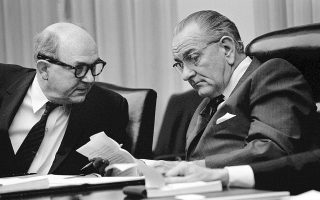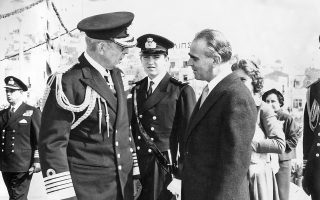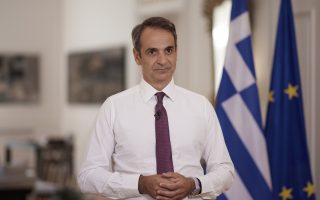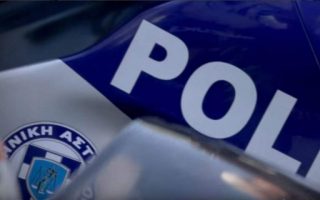An unknown 1974 dogfight over the Aegean
Forty-seven years later, retired air marshal Thomas Skabardonis reveals to Kathimerini the story of his most dangerous engagement
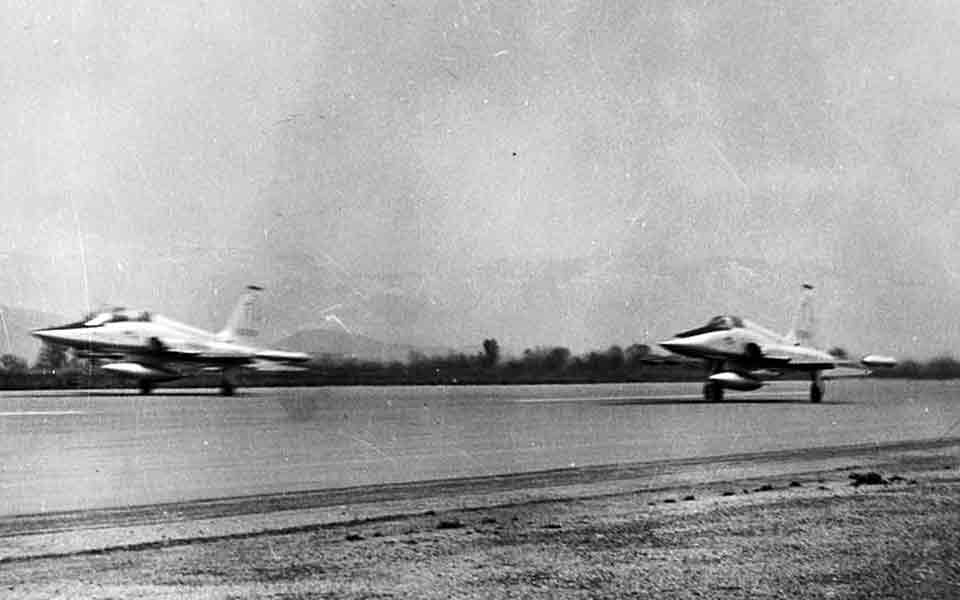
Air Marshal Thomas Skabardonis was a newlywed. He had just taken some time off and was spending it quietly with his wife – who at the time was pregnant with their first child – when he heard the news on the radio. The Turkish Army had just landed on Cyprus, and in response the Greek government had ordered a general mobilization. “It was July 20, 1974. Without any notification, I jumped in my car and immediately drove to the base in Anchialos. From that moment on I was in a state of alertness.”
At the time, the 27-year-old pilot felt little fear about what would follow. Today, 47 years later, the retired air marshal reveals to Kathimerini the story of the most dangerous dogfight of his career. And how, mere days after being on holiday with his wife, he came face to face with two Turkish fighter jets over the Aegean.
A childhood dream
Skabardonis wanted to be a pilot from a young age, when he would watch airplanes fly over his small village of 400 inhabitants, near Lake Plastiras. “It was a passion, and my goal since I was 10,” he recalls. Despite his mother’s fears, when he turned 21, he applied to the Hellenic Air Force Academy – known familiarly as the Icarus School – and was accepted. But as fate would have it, the 1974 general mobilization coincided with the beginning of Skabardonis’ career in the Air Force. “After the Icarus School recruits are assigned to fighter squadrons and then go through a ‘combat phase,’ so to speak. Back then I had just been declared combat-ready.” By July 1974, he had completed his training and been commissioned as a pilot officer.
On alert
Upon arrival at the Nea Anchialos Air Base, 111 Combat Wing, he was immediately placed on high alert. “We were all in our fighter jets, just waiting for a go signal. We were strapped into the ‘two-minute airplanes,’ as we call them. […] Turkish forces kept entering and exiting Aegean [air space].” Despite the intensity of each day and the repeated airspace violations, the atmosphere at the base was calm and collected; there was no fear. “We believed that we would make peaceful interceptions. Neither the unit commander, nor the squadron commander, nor headquarters gave instructions that we should be on guard in case of engagement with the Turks – that is, to defend ourselves.”
In the air without radio
On July 22, his turn to fly had arrived. He was paired with Flying Officer Ioannis Dinopoulos, who was his senior. “They give us the release signal: Fighting pair so-and-so get ready to take off. We start the engines of our jets. Dinopoulos, who was right behind me, approaches, and as soon as he gets beside me signals that he has no radio. In those days, when there was tension or war, you had to take off regardless of your radio. Right after he signals me to go ahead.”
Skabardonis’ and Dinopoulos’ F-5s took off and followed instructions to head for the Aegean, toward the Lemnos area. “The enemy targets were far too many. They kept bringing me up and down: ‘Descend to 10,000 feet,’ ‘Climb to 18,000 feet.’ When I reached 18,000 feet I encountered two Turkish F-102s. I reported through my radio and received peacetime orders: that is, to not turn my weapons switches to the on position in preparation for combat.” He had merely to intercept the two aircraft. “I made a turn toward them, switching from an easterly to a westerly course. In my head I was thinking that since I had given my report, I should be OK. But I got curious and wanted to see what they were doing. I made another turn only to realize that they had practically come right behind me. One was beside me, the other at 6 o’clock. I begin making evasive maneuvers and report that I am engaged with two Turkish aircraft. The only response: ‘Be careful.’ ‘Be careful’ means that you have to avoid them.” As Skabardonis describes it, at that moment he could not allow himself to become overly emotional, the only thought in his mind was escape. “The maneuvers I made were enough to prevent my demise. I reacted instantaneously and managed to escape.”
Dinopoulos’ operation
The Turkish F-102s had not yet detected the second aircraft. “From the moment we took off Dinopoulos was flying at a higher altitude, while keeping me in his field of vision. He saw – I did not – that they fired missiles at me, which missed only because of my evasive maneuvers. Right after he came in from behind them and engaged. He activated his weapons switches but was met with an unexpected delay. His Sidewinder missiles needed to heat up and lock on their targets. For this reason, his first shot missed, but the second hit its target.” As Skabardonis notes, Dinopoulos had the right to shoot since he had seen the Turkish aircraft open fire at his partner. “If it were me in his position, I would have done the same.”
The fall
In that moment, the 27-year-old pilot was unaware of what had transpired. All he got was a quick glimpse of a splash in the sea below him. “I thought to myself, ‘They shot down Dinopoulos.’ The day was quite misty, and the visibility was poor. I tried finding him but couldn’t.” The pilot officer landed at the air base thinking that Dinopoulos had been shot down, but just moments later, the formation leader landed his F-5 on the runway. “My joy was indescribable.” Skabardonis noticed that Dinopoulos’ missiles were missing, instantly understanding that the splash he had seen was from the crash of a Turkish aircraft.
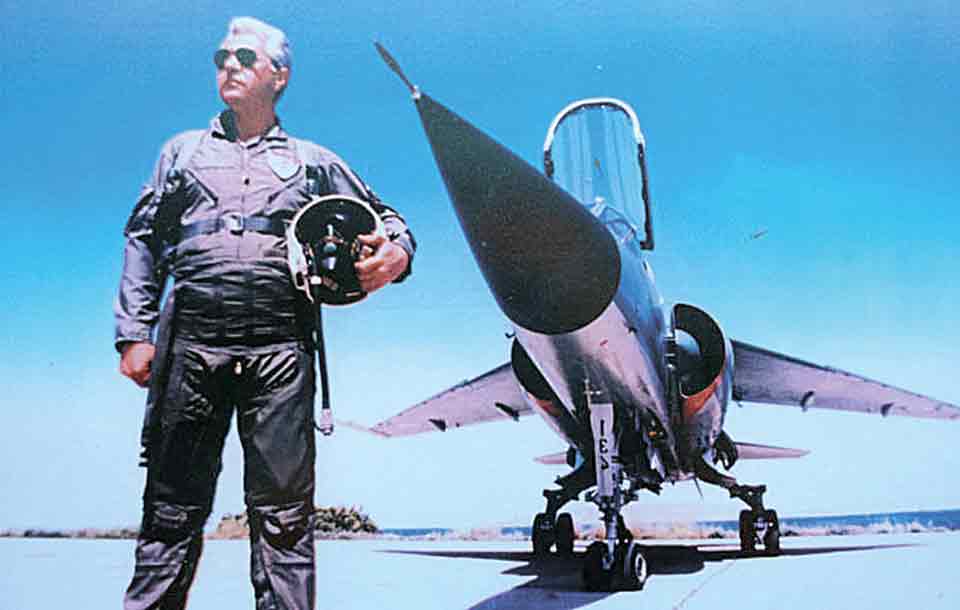
The Larissa debriefs
As soon as they landed, both Greek pilots were separately taken to the Larissa headquarters to give statements about their engagement. Skabardonis reports that they were neither congratulated nor reprimanded after the dogfight. “We were not reprimanded, although our actions could have triggered a serious diplomatic incident.”
A few days later he met with Dinopoulos to discuss what had happened. Dinopoulos’ second missile found its target and took down the Turkish fighter jet which crashed into the sea along with its pilot. After the crash, the other Turkish pilot became confused and according to Skabardonis, flew as far as Corinth. There, he realized that he had flown the wrong way and changed course. Before arriving at the airfield his plane ran out of gas and the pilot was forced into a choppy emergency landing on a Turkish road. He sustained serious injuries and died as a result.
The incident, as Skabardonis points out, was hushed up by the authorities. “It was not even mentioned in our job reports.” He spoke about it years later when he found himself with a Turkish colleague in NATO’s offices in Naples. “He approached me and said, ‘Thomas, in 1974 we shot down two of your planes.’ I replied: ‘If I look like a ghost to you, then yes, you definitely shot us down. I’m the one you supposedly shot down.’ He never approached me again.” As the now 74-year-old air marshal claims, in 1974 Turkey tried to spread propaganda claiming that its air force had shot down the two Greek F-5s.
